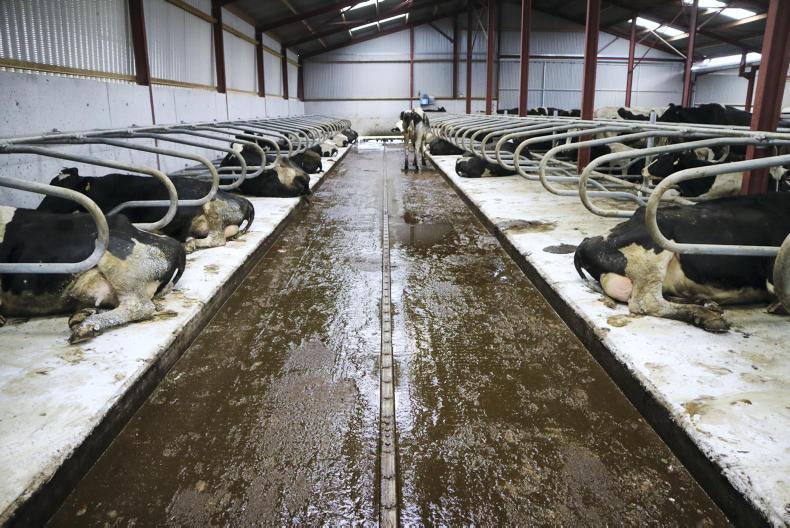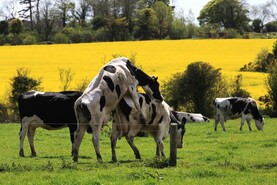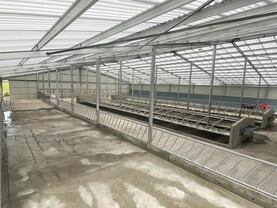Tommy Hogan comes from a mixed beef and tillage farm outside of Borrisokane in Co Tipperary. Over the past year, the farm has been converting some of the 200ac block around the home yard in preparation for a 100-cow dairy herd to begin milking this spring.
While the majority of new entrants will purchase yearling heifers in the year before they start milking, a path less travelled is to purchase cows after they have calved down. However, this is the route that Tommy chose.
“I really wanted to hit the ground running,” Tommy explained, “Not having cows to calve down or calves to rear in the first year will help me to settle in and allow me to concentrate on the cows and grassland management.
“I decided to buy second-, third- and fourth-lactation cows from the beginning of December once the parlour was up and running. I didn’t want any cows here until the parlour was finished. The way I looked at it, three months extra milk production was worth more than a dairy calf,” Tommy said.
“If I had been calving later in the spring I might have gone the yearling heifer route.
“I had a lot of discussions with my vet and he said that buying cows that long before they were due to be bred would give me enough time to implement a comprehensive vaccination programme.”
However, buying freshly calved cows was the more expensive option but Tommy didn’t see this as the area to skimp on.
The farm also operates a considerable beef enterprise and contracting business.
“Cattle were always my first passion but the risk factor with beef is just too high,” Tommy said.
“Feedlots are only getting bigger and bigger. If you are up against someone from a feedlot at the sales ring they could have 2,000-3,000 cattle.”
The central location of the yard on the 200ac block also persuaded Tommy towards beginning a dairy enterprise.
Pictures one and two
While there were plenty of sheds on the farm that could have been adapted to accommodate cubicles, the decision was made when installing a new parlour to also install a cubicle shed that would accommodate the newly established 100-cow herd.

Picture one.
Two adjoining A-roof sheds were built.
Under one roof are the parlour, handling area (which is over slats), and an area that will be used to house calves next year. The adjoining shed has the cubicles and a roofed passageway.

Picture two.
Pictures three, four and five
A 24-unit DeLaval parlour was installed, with the stall work and pit constructed to allow 32 units in the future.
High-yielding Holstein-Friesian cows were the breed of choice as Tommy aimed to maximise milk production while maintaining a one-man unit.
“I want to move to 120 cows and get as much milk as I can as a one-man unit,” he said.
“The plan is to max out a one-man operation with cows at an average of 9,000 litres.”

Picture three.
The Targeted Agricultural Modernisation Scheme (TAMS) was used to help pay for the milking equipment as this was the most straightforward aspect to pay for.
"The milking machine came to approximately €72,000 excluding VAT.
"Tommy no longer qualifies as a young farmer, as he has been farming more than five years, so he was eligible for a 40% grant. He hopes to claim back a grant of €28,800.
A new milk machine, or an extension to a current milking parlour has a reference cost of €2,986.17/unit.
The parlour is fitted with automatic cluster removers while it also has milk yield indicators.

Picture four.
“The milk indicators were the best investment I have made. When you are trying to put a herd together you need to know straight away what cows are milking well and what cows are not. It is something that a lot of farmers going for a more basic parlour will miss out on,” Tommy said.
“The most important reason for them is herd health. If there is something wrong with a cow the first thing she will do is slow down in terms of milk production. The earlier you can pick up an issue the better.”
There are individual feeding stalls and a zig-zag rump rail to position cows correctly for milking.
Stalls are installed at 2ft 6in centres and at a 50° angle to the pit.

Picture five.
Portumna Farm and Dairy Services installed the parlour and all associated fittings.
“Like most people, the most important thing for me with a parlour is after-sales service, especially when you are a new entrant starting out,” Tommy said.
“Any issues I have had so far I have been able to sort over the phone with a bit of guidance.”
After researching a few different options, Tommy decided to go for a secondhand bulk tank from Intercool Engineering in Ashbourne, Co Meath. The 12,000l tank came with two new 5hp compressors and a new auto-wash unit.
The tank is three years old and cost €21,000 plus VAT. A new tank of the same size would have cost €30,000 plus VAT, according to Tommy.
Picture six
The milking machine is compatible with a feed-to-yield system.
However, while not the first choice, batch feeders were installed to keep control of costs when starting out.
The plan will be to fit individual feeders in the future.

Picture six.
“With high-yielding cows, one of the biggest challenges is to get them back in-calf,” Tommy explained.
“So being able to designate each cow’s feed would be a bonus but we have to stagger the investment.”
Picture seven
The positioning of the parlour means cows have a straight entrance into the collecting yard when they are out at grass.
It is at the edge of the yard so milking will not interrupt other work around the yard.

Picture seven.
The position of the collecting yard means that it can be extended straight back if the herd expands.
A 1.2m-deep slurry channel runs across the back of the parlour, or across the front of the collecting yard which will collect dirty water and channel it to a large slatted tank.
Picture eight
When cows exit the parlour they will do a U-turn and move back over a slatted handling area, out towards the milking platform.

Picture eight.
Cows have 3.7m from the end of the parlour to the wall to ensure cow flow is not compromised upon exiting the parlour.
Picture nine
A large crush has been installed running along one wall while an automatic drafting unit is to be installed along the other wall before the grazing season starts.
The large tank is approximately 36m long and fitted with 4.4m slats.
The tank has an internal width of 4.1m and a depth of 2.4m.

Picture nine.
This tank will be used for dirty water and parlour washings and has a net storage of 324m3. This is including a 200mm free space at the top of the tank which must be left.
Water for washing is harvested from the roof of the sheds and from the plate cooler and stored in a 25,000l underground tank.
Between the milking parlour and the cubicle shed is an area that will be used to hold calves from next spring.
For this year, it is only used for storage as no calves are present on the farm. There will be a total of eight pens here, with five used to hold groups of calves.
Pens are 8.2m by 4.8m, meaning there is 39m2/pen. This would give space for approximately 20 calves/pen at 1.95m2/calf. In an ideal design, cows and calves would be housed in individual buildings so as to not share the same airspace.
Grasstec completed the drawings and planning application for the entire project.
Pictures 10 and 11
A new three-row cubicle design shed was also constructed.
A single row of 2.74m-long cubicles lines the back wall of the shed, with 1.84m mats and a 0.9m lunge zone.

Picture ten.
Head-to-head cubicles measure 4.63m with a 0.95 lunge zone between mats.
Cubicles were supplied and fitted by O’Donovan Engineering, while mats were supplied by Easyfix.
Along the back of the shed is a 2.74m-wide passageway.
The slatted passageway along the feed barrier is 5m wide. Automatic scrapers run along both passageways and feed into the L-shaped tank in the shed.
The shed was supplied and erected by O’Dwyer steel while all sheeting was supplied by Tegral.

Picture eleven.
Fibre cement sheeting is in place throughout the roof of both sheds. All concrete work for the shed was completed by Liam and Dermot O’Mara of OMB.
Tommy had a special word of thanks to his family for the support over the past year.
“This would never have been done if it wasn’t for the support of my wife Michelle and my parents Martin and Mary throughout the entire process.”
Tommy Hogan comes from a mixed beef and tillage farm outside of Borrisokane in Co Tipperary. Over the past year, the farm has been converting some of the 200ac block around the home yard in preparation for a 100-cow dairy herd to begin milking this spring.
While the majority of new entrants will purchase yearling heifers in the year before they start milking, a path less travelled is to purchase cows after they have calved down. However, this is the route that Tommy chose.
“I really wanted to hit the ground running,” Tommy explained, “Not having cows to calve down or calves to rear in the first year will help me to settle in and allow me to concentrate on the cows and grassland management.
“I decided to buy second-, third- and fourth-lactation cows from the beginning of December once the parlour was up and running. I didn’t want any cows here until the parlour was finished. The way I looked at it, three months extra milk production was worth more than a dairy calf,” Tommy said.
“If I had been calving later in the spring I might have gone the yearling heifer route.
“I had a lot of discussions with my vet and he said that buying cows that long before they were due to be bred would give me enough time to implement a comprehensive vaccination programme.”
However, buying freshly calved cows was the more expensive option but Tommy didn’t see this as the area to skimp on.
The farm also operates a considerable beef enterprise and contracting business.
“Cattle were always my first passion but the risk factor with beef is just too high,” Tommy said.
“Feedlots are only getting bigger and bigger. If you are up against someone from a feedlot at the sales ring they could have 2,000-3,000 cattle.”
The central location of the yard on the 200ac block also persuaded Tommy towards beginning a dairy enterprise.
Pictures one and two
While there were plenty of sheds on the farm that could have been adapted to accommodate cubicles, the decision was made when installing a new parlour to also install a cubicle shed that would accommodate the newly established 100-cow herd.

Picture one.
Two adjoining A-roof sheds were built.
Under one roof are the parlour, handling area (which is over slats), and an area that will be used to house calves next year. The adjoining shed has the cubicles and a roofed passageway.

Picture two.
Pictures three, four and five
A 24-unit DeLaval parlour was installed, with the stall work and pit constructed to allow 32 units in the future.
High-yielding Holstein-Friesian cows were the breed of choice as Tommy aimed to maximise milk production while maintaining a one-man unit.
“I want to move to 120 cows and get as much milk as I can as a one-man unit,” he said.
“The plan is to max out a one-man operation with cows at an average of 9,000 litres.”

Picture three.
The Targeted Agricultural Modernisation Scheme (TAMS) was used to help pay for the milking equipment as this was the most straightforward aspect to pay for.
"The milking machine came to approximately €72,000 excluding VAT.
"Tommy no longer qualifies as a young farmer, as he has been farming more than five years, so he was eligible for a 40% grant. He hopes to claim back a grant of €28,800.
A new milk machine, or an extension to a current milking parlour has a reference cost of €2,986.17/unit.
The parlour is fitted with automatic cluster removers while it also has milk yield indicators.

Picture four.
“The milk indicators were the best investment I have made. When you are trying to put a herd together you need to know straight away what cows are milking well and what cows are not. It is something that a lot of farmers going for a more basic parlour will miss out on,” Tommy said.
“The most important reason for them is herd health. If there is something wrong with a cow the first thing she will do is slow down in terms of milk production. The earlier you can pick up an issue the better.”
There are individual feeding stalls and a zig-zag rump rail to position cows correctly for milking.
Stalls are installed at 2ft 6in centres and at a 50° angle to the pit.

Picture five.
Portumna Farm and Dairy Services installed the parlour and all associated fittings.
“Like most people, the most important thing for me with a parlour is after-sales service, especially when you are a new entrant starting out,” Tommy said.
“Any issues I have had so far I have been able to sort over the phone with a bit of guidance.”
After researching a few different options, Tommy decided to go for a secondhand bulk tank from Intercool Engineering in Ashbourne, Co Meath. The 12,000l tank came with two new 5hp compressors and a new auto-wash unit.
The tank is three years old and cost €21,000 plus VAT. A new tank of the same size would have cost €30,000 plus VAT, according to Tommy.
Picture six
The milking machine is compatible with a feed-to-yield system.
However, while not the first choice, batch feeders were installed to keep control of costs when starting out.
The plan will be to fit individual feeders in the future.

Picture six.
“With high-yielding cows, one of the biggest challenges is to get them back in-calf,” Tommy explained.
“So being able to designate each cow’s feed would be a bonus but we have to stagger the investment.”
Picture seven
The positioning of the parlour means cows have a straight entrance into the collecting yard when they are out at grass.
It is at the edge of the yard so milking will not interrupt other work around the yard.

Picture seven.
The position of the collecting yard means that it can be extended straight back if the herd expands.
A 1.2m-deep slurry channel runs across the back of the parlour, or across the front of the collecting yard which will collect dirty water and channel it to a large slatted tank.
Picture eight
When cows exit the parlour they will do a U-turn and move back over a slatted handling area, out towards the milking platform.

Picture eight.
Cows have 3.7m from the end of the parlour to the wall to ensure cow flow is not compromised upon exiting the parlour.
Picture nine
A large crush has been installed running along one wall while an automatic drafting unit is to be installed along the other wall before the grazing season starts.
The large tank is approximately 36m long and fitted with 4.4m slats.
The tank has an internal width of 4.1m and a depth of 2.4m.

Picture nine.
This tank will be used for dirty water and parlour washings and has a net storage of 324m3. This is including a 200mm free space at the top of the tank which must be left.
Water for washing is harvested from the roof of the sheds and from the plate cooler and stored in a 25,000l underground tank.
Between the milking parlour and the cubicle shed is an area that will be used to hold calves from next spring.
For this year, it is only used for storage as no calves are present on the farm. There will be a total of eight pens here, with five used to hold groups of calves.
Pens are 8.2m by 4.8m, meaning there is 39m2/pen. This would give space for approximately 20 calves/pen at 1.95m2/calf. In an ideal design, cows and calves would be housed in individual buildings so as to not share the same airspace.
Grasstec completed the drawings and planning application for the entire project.
Pictures 10 and 11
A new three-row cubicle design shed was also constructed.
A single row of 2.74m-long cubicles lines the back wall of the shed, with 1.84m mats and a 0.9m lunge zone.

Picture ten.
Head-to-head cubicles measure 4.63m with a 0.95 lunge zone between mats.
Cubicles were supplied and fitted by O’Donovan Engineering, while mats were supplied by Easyfix.
Along the back of the shed is a 2.74m-wide passageway.
The slatted passageway along the feed barrier is 5m wide. Automatic scrapers run along both passageways and feed into the L-shaped tank in the shed.
The shed was supplied and erected by O’Dwyer steel while all sheeting was supplied by Tegral.

Picture eleven.
Fibre cement sheeting is in place throughout the roof of both sheds. All concrete work for the shed was completed by Liam and Dermot O’Mara of OMB.
Tommy had a special word of thanks to his family for the support over the past year.
“This would never have been done if it wasn’t for the support of my wife Michelle and my parents Martin and Mary throughout the entire process.”

















 This is a subscriber-only article
This is a subscriber-only article











SHARING OPTIONS: